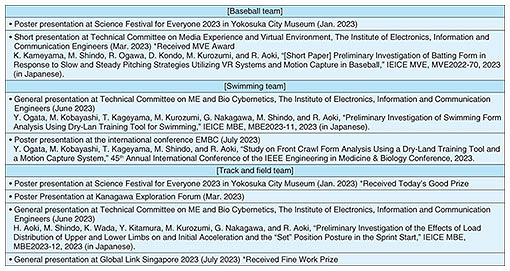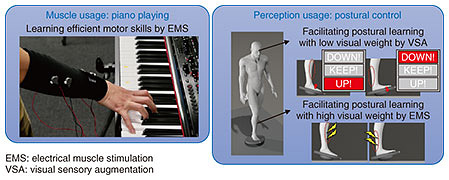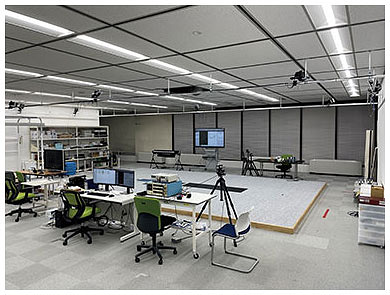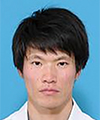 |
|||||||||||
|
|
|||||||||||
|
Special Report Vol. 22, No. 1, pp. 90–96, Jan. 2024. https://doi.org/10.53829/ntr202401sc1 Growth Record of Kanagawa Prefectural Yokosuka Senior High School Students Becoming Sports Analysts—Introducing NTT Human Informatics Laboratories’ Contribution Activities to the Local CommunityAbstractNTT Human Informatics Laboratories has been engaged in collaborative research with students from Kanagawa Prefectural Yokosuka Senior High School under the research theme of “Let’s experience being sports analysts” since 2022 as part of its support for the school’s Super Science High School program. This article introduces interviews with NTT researchers who have been involved in local-community-contribution activities aimed at nurturing young researchers along with the lead teacher from Kanagawa Prefectural Yokosuka Senior High School. Keywords: local-community-contribution activities, sports analyst, motor-skill transfer technology 1. IntroductionThe Ministry of Education, Culture, Sports, Science and Technology has implemented the Super Science High School (SSH) program with the aim of nurturing science and technology talent capable of international contributions through advanced education in mathematics and science at high schools. Kanagawa Prefectural Yokosuka Senior High School (Yokosuka High School) has been designated as an SSH school since fiscal year (FY) 2016 and has developed a unique curriculum to foster students’ exploratory activities. Yokosuka High School’s SSH program is structured as a mandatory course throughout the three years of high school. One particularly distinctive feature is that the first-year students engage in exploratory activities alongside researchers working at the forefront of research. Yokosuka High School collaborates with multiple research institutions, including universities and companies in the surrounding area. On the basis of research themes proposed by these institutions, students choose a research institution that piques their interest and carry out exploratory activities. NTT has also been supporting exploratory activities for first-year students since Yokosuka High School was designated an SSH school in FY2016. Since FY2022, NTT Human Informatics Laboratories (hereafter, the Laboratories) has accepted first-year students under the research theme “Let’s experience being sports analysts.” The Laboratories has also begun supporting the SSH program by positioning this theme as collaborative research. In this research, the Laboratories not only facilitates students’ exploratory activities but also promotes research endeavors in which the ideas of high school students contribute to the academic achievements supporting the advancement of motor-skill-transfer technology conducted by the Laboratories. Some of the research results have received high academic acclaim, culminating in presentations at gatherings attended by leading researchers (Table 1).
This article introduces interviews with NTT researchers involved in recent community engagement activities focused on nurturing young researchers (Ryosuke Aoki and Masato Shindo), along with the lead teacher from Yokosuka High School for FY2022 (Mika Kurozumi, currently a teacher at Kanagawa Prefectural Shirosato Senior High School). 2. Motor-skill-transfer technology and experimental facilities of the LaboratoriesThe Laboratories is conducting research and development (R&D) on motor-skill-transfer technology and studying how to directly transfer motor skills of experts, which are generally difficult to convey with words or video, by external sensory stimulations such as electrical stimulation [1]. With postural control while standing [2] and piano-playing techniques [3, 4] as areas of investigation, researchers at the Laboratories are researching techniques for transferring motor skills, such as the use of muscles and sensory perception, by combining involuntary and voluntary movements using external stimulations such as electrical muscle stimulation (Fig. 1). They are also conducting research on quantifying motor skills and motor habits to expand the range of applications of such technologies. The Laboratories has measurement systems for supporting learning motor skills and motion-analysis equipment for providing external stimulations at Yokosuka R&D Center (Fig. 2).
Ryosuke Aoki, introduced in this article, oversees the entire research on motor-skill-transfer technology. Masato Shindo, also introduced here, is in charge of motion analysis and learning motor skills related to postural control to prevent loss of ability due to conditions such as aging. 3. Background of research theme settings to elicit high school students’ interestThe theme proposed by NTT to Yokosuka High School, “Let’s experience being sports analysts,” aims to inspire students to identify habitual movements in their respective sports activities and uncover the techniques used by skilled individuals. The objective is for students to leverage these insights to improve their performance. Even though basic research on motor analysis generally concentrates on gait and posture, Aoki decided to target sports-club activities instead to encourage students to maintain their interest outside the classroom and create a cycle through which students can put into practice their respective sports activities what they have questioned in class. Shindo, who was a student of another high school’s SSH program, also understood the challenges of maintaining interest and felt that this approach will be effective. As anticipated by Kurozumi, this theme setting and Aoki’s presentation, which were designed to spark interest from the students’ perspective, resulted in a significantly higher number of students applying for this theme than the expected limit of 20. The high school adjusted by selecting students with clear reasons for applying to meet the set capacity. However, there were students with a compelling desire to conduct research specifically with NTT, so the final participant count reached 22. This underscores how compelling both the theme and presentation were. The NTT SSH class ended up consisting of 3 students from the baseball team, 3 from the track and field team, 3 from the swimming team, 3 from the badminton team, 4 from the tennis team, 1 from the archery team, 1 from the soccer team, 2 from the basketball team, 1 from the volleyball team, and 1 from the Sports Chanbara (a modern Japanese martial art) circle. For students who were the only student of their respective sports, NTT researchers highlighted the challenges of working alone. Although the researchers encouraged them to form groups to investigate common movements in their sports such as jumping, the students rejected the suggestion due to the distinct processes involved in each sport, even if the movements were similar. The NTT researchers respected this and accommodated their preferences. 4. Flexible lesson design to sustain high school students’ interest in weekly SSH classesIn the weekly SSH classes, various strategies were implemented to sustain the interest of high school students. Thanks to these efforts, Kurozumi mentioned that students were excited and their eyes sparkled. During the opening 5 to 10 minutes of each class in the beginning stage, Aoki explained the relationship between subjects typically studied in high school and the connection between physical activity and muscle use. This approach was aimed at redirecting students’ attention to their immediate surroundings. The curriculum design also incorporated flexible elements at the beginning stage. The initial plan was for students to investigate literature and explanatory videos related to the evaluation of sports they found interesting, leading to hypothesis construction. However, observing challenges with this approach, the focus shifted towards helping students understand how their chosen sports were represented through actual data. By measuring and observing waveform graphs that changed in conjunction with their movements, students gained a new perspective on analyzing body movements, gradually clarifying initially vague issues. Reflecting on the process, Shindo mentioned that if too much time had been spent on researching peripheral technologies or specifying measurement details, such significant results (Table 1) would not have been achieved within the short span of one year. Special attention was also given to how assignments were given to the students. If they were instructed in the same manner as NTT researchers, such as “investigate current research and consider what measures you want to take,” it is conceivable that they might struggle to generate ideas due to a lack of research experience. Recognizing that too much freedom might hinder the students from taking action, while being too focused might stifle their initiative, the researchers and Kurozumi devised assignments with a scope that enabled students to act independently. They encouraged the students to carry out tasks within the assigned parameters. The first assignment initially involved searching for “what is generally said in the world” and “what your coach says.” However, even with these constraints, students found it challenging to narrow down measurement items. Consequently, the researchers and Kurozumi modified the assignment to focus on determining measurement items by examining body movements they wanted to measure. This included repeatedly confirming measurement data in the lab while changing measurement conditions each time. Kurozumi also took measures to ensure that students remained motivated. Kurozumi understood the challenge of maintaining students’ motivation if they were only assigned SSH tasks once a week as homework. To prevent the weekly sessions with the NTT researchers from being unproductive, she actively engaged with the students by referencing what they wrote in their review cards submitted after each lesson. When passing them in the hall, she would ask questions such as, “Have you investigated XX?” Responses such as “Oh no, I haven’t! I’ll do it!” prompted the students into action. The students’ awareness that their teacher paid attention to their progress heightened their motivation and sustained their interest. The students received support not only during classes but also through Kurozumi’s behind-the-scenes encouragement such as reaching out to them outside of class. 5. NTT researchers’ experience of challenges and delight during measurements and analysisThe NTT researchers faced difficulties in interpreting the measurement data collected by high school students but were experiencing joy that surpassed those difficulties. Both Aoki and Shindo were tackling sports-analysis and motor-learning research perspectives for the first time in any sport. Thus, they did not have prior knowledge or expertise in current research for each sport. Both were exploring the measurement targets and visualization content in a trial-and-error manner. Even with information gathered from students in various sports clubs, not all students could clearly articulate what they wanted to measure. It was more of a sensory awareness. Respecting this awareness, both researchers engaged in multiple discussions with the students, drawing on their own research insights and personal athletic experiences. They initially decided on measurement conditions and parameters somewhat vaguely, prioritizing the quantification and visualization of those aspects over the development of novel hypotheses. This approach was aimed at articulating the sensory aspects through discussions, leveraging the researchers’ knowledge and their experiences in movement. As visualizing measurement data solely in graph form posed challenges for high school students to interpret, the NTT researchers decided to provide guidance by proposing comparative elements. In preparing these considerations, it was necessary to change their mindset to organize results for each sport due to the completely different experimental tasks, measurement content, and verification criteria in each sports club. Shindo recalled that this was the most difficult part. Kurozumi expressed great appreciation for the efforts of both researchers as they individually measured and visualized movements for all sports clubs, finding it truly impressive. The challenges faced by the two researchers as they repeatedly considered these activities for all ten sports clubs must have seemed unsurmountable. Particularly for Shindo, who was in his third year at the company at that time and was already grappling with the demands of paper publication for his own research, handling and guiding high school students proved to be challenging. Aoki fondly recalled that during this time, Shindo, despite being in his third year at the company, would occasionally express his challenges while dealing with high school students, but he persevered. However, as the two researchers delved into experiments based on the ideas of high school students, the excitement of unexpected results seemed to outweigh the difficulties. According to Kurozumi, the students, who may not have immediately grasped the interesting aspects of the results, were envious of the genuine enjoyment demonstrated by both researchers. This envy motivated the students to seek and experience the same excitement in their endeavors. 6. Struggles and growth in Yokosuka High School students in interpreting visualized measurement dataThe NTT researchers shared the visualized data. It was now time for the students to show their abilities. The students needed to compare the visualized data under different conditions, reflect on their sensory awareness while making regular observations, and consider whether additional experiments were necessary. This section introduces the challenges and growth of Yokosuka High School students and teachers, which were unknown to the NTT researchers. Kurozumi assisted in setting up the personal computers for students to use the analytical software MATLAB, and Shindo shared the visualized data. However, the students found the data challenging to interpret. Some students expressed frustration such as, “I don’t want to look at the data anymore,” “I can’t take it anymore,” and “I don’t understand what I don’t understand.” To help students clarify their vague comments, Kurozumi dedicated time outside of SSH class for discussions. During these sessions, they collectively examined what they did not understand and worked to clarify areas of confusion. Kurozumi would prompt students with questions like, “I don’t know either, so can you tell me what you don’t understand?” This approach encouraged students to articulate their uncertainties, such as, “This graph is telling me something, but what is the meaning of this number here?” This effort facilitated the verbalization of their questions and, through patient repetition, enabled students to clarify their thoughts to some extent. Subsequently, during SSH class time, students engaged in discussions with the NTT researchers about their questions. Kurozumi’s support played a crucial role in sustaining the students’ motivation and enhancing the quality of the limited discussion sessions with the researchers. Aoki and Shindo expressed gratitude to Kurozumi for enabling this support, considering the constraints on the time they themselves had available for assistance. As students began to comprehend the visualized data, they proactively approached the researchers, asking, “Is it possible to create such a graph?” Some students sought guidance on generating more detailed graphs as they correlated movements to graphs and learned the outputs at specific times. The strong collaboration between Kurozumi and the NTT researchers helped the students overcome obstacles. It can be truly said that the growth of the students lay in the relationships of trust between the researchers and Kurozumi and the students. Kurozumi, Shindo, and Aoki confirmed students’ progress together by reviewing their comment cards after each class. They also carried out attentive care of students who were not making expected progress. 7. Chain of growthAs Aoki and Shindo proceeded to investigate the results of the ten different sports, the outcomes of some teams appeared to be worthy of academic discussion. For the baseball and swimming teams, in particular, it was deemed valuable to report on case studies even at the stage of setting research issues. Therefore, the NTT researchers were encouraged to present these findings at domestic research conferences and academic meetings. The baseball team was the first team to present their findings at a domestic research conference. Talk of presenting at an academic conference alongside researchers from companies and universities naturally spread throughout the school, and some students became interested in participating. Following the baseball team, while preparing for the submission of the swimming team’s outcomes, students from the track and field team approached, inquiring about what was needed for them to present at an academic conference. When Aoki told the students that their current research findings were not sufficient for discussion at research conferences and that they needed to conduct more experiments to dig deeper into the initial results, the students took the initiative in revising their experimental plan with Shindo. They conducted the experiments, asking classmates on the track and field team to assist and participate. When the researchers told them about items that should be investigated on the basis of the visualized measurement data, the students found time to meet and discuss on their own, gathering during lunch and after school. The SSH students acquired the ability to interpret measurement data. Motivated by the prospect of presenting at conferences, they started to experience the thrill of research and became deeply engrossed in data analysis. This independent thinking and proactive approach align with the qualities of researchers, embodying the perspective of a sports analyst that Kurozumi and the NTT researchers had aimed for the students to develop. Finally, it took less than two months from Aoki’s comment when the track and field team submitted their poster to the conference. One can easily envision the tremendous efforts invested by the students to accomplish their tasks within this relatively short timeframe. Simultaneously, the researchers undertook numerous behind-the-scenes responsibilities, including assessing the protection of personal information, making adjustments on the basis of feedback from NTT’s ethics committee, reviewing research literature to articulate the experiment’s novelty, and meticulously planning the experiments and analysis. I believe the two researchers demonstrated exceptional responsiveness to the students’ enthusiasm. 8. Comment by the interviewer (Kaori Kataoka)The baseball, swimming, and track and field teams have already given presentations at public conferences. The first-year students in other sports teams also presented posters at the school in March [5]. Although all participants could present their results at the end of the school year, in March, it was challenging for small groups of one or two students to continue when the SSH students became 2nd-year students. After finishing their poster presentation, some students approached Kurozumi and said, “I worked hard, didn’t I?” The presence of peers who can support each other in the same position is significant. Due to the rules, adding personnel is challenging, and the sports teams that are currently continuing consist of three or more members. However, there were comments in the final reflection cards stating, “I now understand what research is,” and I can imagine that this was a rewarding moment for both Kurozumi and the NTT researchers. When faced with questions from researchers that might initially seem critical, such as “What do you think about this? Why did you write that?” the students candidly reflected, wondering why they wrote what they did and taking it as an opportunity for introspection. I was impressed by how they saw it as a chance for growth. To all readers, I hope that through the introduction of NTT’s local-community-contribution activities, I can deliver a bit of inspiration for tomorrow. References
|
|||||||||||













